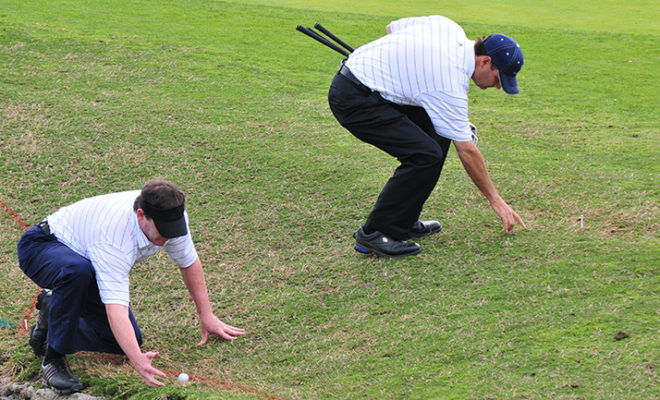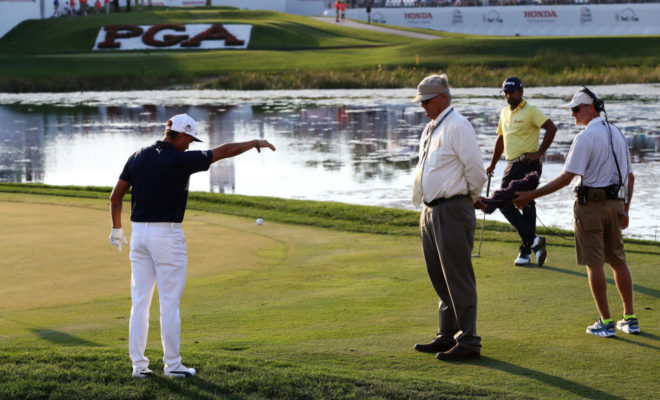The USGA’s Major Proposed Changes to the Rules of Golf

For the first time since 1984, the USGA and R&A are expected to finalize a comprehensive set of new rules that will go into effect Jan. 1, 2019. The proposed rule changes aim to modernize the sport, improve pace of play and make the rules easier to understand and apply for all golfers. Take a look and let us know which you think are most important in the comments.
Ball at Rest
- Ball Moved During Search – No penalty for accidentally moving your ball during search.
- No Penalty for Moving Ball on the Putting Green – No penalty for accidentally moving your ball or ball-marker on the putting green.
- Standard for Deciding Why a Ball Moved – New standard to determine if you caused your ball to move.
- Replacing Ball When Original Spot is Not Known – When the original location of a ball is not known, replace the ball on its estimated spot.
Ball in Motion
- Ball in Motion Accidentally Deflected – No penalty if your ball in motion is accidentally deflected by you, your equipment, or your caddie.
Taking Relief
- Measuring the Size of the Relief Area Where a Ball Must Be Dropped and Played – The focus of the new dropping procedure would be on a specific “relief area” of either 20 or 80 inches from a reference point or reference line.
- Proposed New Procedure for Dropping a Ball – The only requirement will be for you to hold the ball above the ground and let it go so that it falls through the air before coming to rest.
- Where a Dropped Ball Must Come to Rest – The ball must come to rest in the relief area where it was dropped, or else the ball must be redropped.
- Fixed Distance (Not Club-Lengths) Used for Measuring – The relief area will be measured by a fixed distance of either 20 or 80 inches from the reference point or the reference line.
- Time For Search Before Ball is Lost – A ball is lost if not found in three minutes (rather than the current 5 minutes).
- Substitution of Ball Always Allowed When Taking Relief – A player may always substitute a ball when taking relief.
- Relief For an Embedded Ball – Relief allowed without penalty for an embedded ball anywhere (except in sand) in the “general area” (a new term for “through the green”).
Areas of the Course
- When to Replace a Ball That Moves on the Putting Green – After your ball has been lifted and replaced, you would always replace your ball on its original spot, even if it was blown by the wind or moved for no clear reason.
- Repairing Damage on the Putting Green – Repair of almost any damage allowed on the putting green (including spike marks and animal damage).
- Touching Line of Play on a Putting Green – No penalty for touching your line of play on the putting green so long as doing so does not improve the conditions for your stroke.
- Ball Played From Green Hits Unattended Flagstick in Hole – No penalty if your ball played from the putting green (or anywhere else) hits the unattended flagstick in the hole.
- Areas the Committee May Mark as Penalty Areas – Areas of desert, jungle, lava rock, etc. (in addition to areas of water) may now be marked as red or yellow “penalty areas.”
- Touching or Moving Loose Impediments or Touching the Ground in a Penalty Area – No penalty for moving loose impediments, touching the ground, or grounding your club in a penalty area.
- Expanded Use of Red-Marked Penalty Areas – Committees are given the discretion to mark any penalty area as red so that lateral relief is always allowed.
- Elimination of Opposite Side Relief for Red Penalty Areas – Relief from a red penalty area no longer allowed on the opposite side from where the ball last entered the penalty area.
- Moving or Touching Loose Impediments or Touching Sand in a Bunker – Relaxed Rules relating to loose impediments and touching the ground in a bunker.
- Unplayable Ball in Bunker – Relief allowed outside a bunker for an unplayable ball for two penalty strokes.
Equipment
- Use of Clubs Damaged During Round – A club damaged during a round can continue to be used, even if you damaged it in anger.
- Adding Clubs to Replace a Club Damaged During Round – You will not be allowed to replace a damaged club during a round if you were responsible for the damage.
- Use of Distance-Measuring Devices – The use of DMDs will be allowed unless a Local Rule has been adopted prohibiting their use.
Playing a Ball
- Caddie Standing Behind a Player to Help Line the Player Up – A caddie is not allowed to stand on a line behind a player while the player is taking his or her stance and until stroke is made.
- Caddie Lifting Ball on the Putting Green – A caddie may lift and replace a player’s ball on the putting green without the player’s specific authorization to do so.
When to Play During a Round
- Encouraging Prompt Pace of Play – It is recommended that you play “ready golf” and make each stroke in no more than 40 seconds.
- Maximum Score Form of Stroke Play – A new “Maximum Score” form of stroke play is recognized, where a player’s score for a hole is capped at a max score.
Player Behavior
- Expected Standards of Player Conduct – The proposed new Rules speak to the high standards of conduct expected from players.
- Code of Player Conduct – Committees are given authority to adopt their own code of player conduct and to set penalties for breaches of that code.
- Elimination of the Requirement to Announce the Player’s Intent to Lift a Ball – When you have good reason to mark and lift your ball, you are no longer required to first announce your intention.
- Reasonable Judgment in Estimating and Measuring – A player’s reasonable judgment will not be second-guessed based on later evidence.











Why are we waiting another year to implement these good changes?
At first read I am excited about the new rules. I still remember that penalty I received for hitting the flagstick when putting during my club tournament Our foursome was running behind and it was such a difficult long putt, I took my stroke never dreaming I would make it to the hole.
Quite a few amateur golfers don’t rake their footprints after playing out of sand traps. I always felt it was not fair to those players who do rake the the sand every time to have to play out of someone else’s footprints or divots. A free drop in the sand would be appropriate after consulting with other players in group, and then raking the foot prints.
Love all the rule changes but i agree, why are they waiting until 2019 for this? The “rules” committee should be trying to make golf more fun asap not trying to keep some “integrity” to the game. If golf was more fun and not so penal with everything, maybe more people would enjoy the game. Courses are closing up shop everywhere, we need to make this great game more enjoyable, especially for the 99.9% of amateurs that play it.
Thank you, you guys are doing a great job. love the idea that we have some time to discuss these new rules with our members. Good work!
In the example of moving loose impediments in a bunker, there is no example shown for rocks. Often rocks are encountered that are near the swing line and could damage a club or deflect the swing path and may become an injury hazard to the player or nearby players.
1. Can rocks be removed in the new rule?
2. If removal is OK, can you add that to the example video?
Currently, by local rule only, stones in bunkers can be deemed to be movable obstructions and removed but again that is by local rule only.
Where’s the rule change granting relief without penalty when one’s perfect drive down the middle of the fairway comes to rest in someone else’s unrepaired divot?
Thanks.